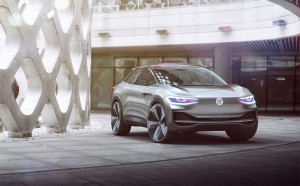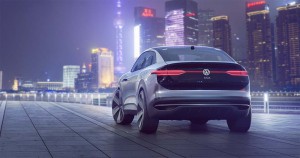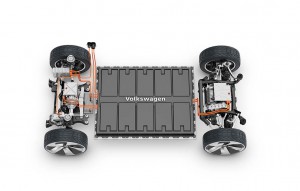
Volkswagen's third concept vehicle in the I.D. EV line-up is the I.D. Crozz. The ute could be VW's first EV entry into China.
Volkswagen has pulled the wraps off the third of its I.D. battery-car concept vehicles, offering a hint of what might be in store when it launches its first electric vehicle in China later this year.
VW brand boss Herbert Diess has already promised to put 30 battery models into production by 2025, and many of them are expected to carry the new I.D. sub-brand badge. The German automaker is largely shifting from diesel to battery power in the wake of its emissions scandal. But it is also facing pressure from governments around the world – China, in particular – to adopt new zero-emissions technologies.
So far, VW isn’t saying which battery model will be launched in China this year. It is likely that it will go with an existing product, such as the e-Golf. But Diess is suggesting that the new I.D. Crozz is being viewed as more than just a concept, with the battery-SUV likely to reach showrooms no later than 2020.
How fast it actually makes it into production may depend on what Chinese regulators decide to do with their current battery-car regulations. The government has been under pressure to relax current rules that the industry feels are too aggressive.
(Volkswagen spending $300M to begin electrifying America. For the details, Click Here.)
“The rules look like they are being revised,” VW China CEO Jochem Heizmann said ahead of the opening of the Shanghai Motor Show. But automakers like Volkswagen say they may be forced to move quickly into the Chinese market with at least EVs if the revisions don’t come soon.
With its coupe-like crossover body, VW is describing the new I.D. Crozz as a “key pillar” of its new electrification strategy. The electrified ute draws power from an 83 kilowatt-hour lithium-ion battery pack mounted in the vehicle’s floor, a move meant to lower its center of gravity and free up space for passengers and cargo.
The battery pack is paired with two electric motors. The one in the rear produces 201 horsepower, with the motor on the front axle producing an additional 101 horsepower. Together, VW says the pair of motors can launch the I.D. Crozz from 0 to 60 in less than 6 seconds, with a top speed of 112 mph. Driven less aggressively, range is estimated at 311 miles using the New European Driving Cycle test. The tougher EPA standard would likely drop that number by about 25%.
(Click Here to see how the diesel scandal has impacted VW profits.)
To put it into context, VW says the I.D. Crozz boasts about the same interior space as the all-new 2018 Tiguan. It is loaded with high-tech features including a head-up display, a reconfigurable “Active Info” display, a tablet-like control system for its infotainment package and the new I.D. Pilot autonomous driving system.
LIDAR scanners on the corners of the roof, paired with cameras and radar, allow the four-seat I.D. Crozz to go fully autonomous.
In manual mode, all relevant vehicle information, including speed, is displayed through the HUD system. To switch to autonomous driving, the driver would simply touch the VW logo on the steering wheel’s “illuminated sensory surface” for three seconds. At that point, adds the automaker, “The steering wheel then retracts into a flush position within the dashpad.”
When the I.D. Crozz is shut off, its headlights appear to looks like “its eyes are closed.” When the vehicle starts, it triggers a 360-degree “light show,” the maker adds, while also noting that the vehicle interacts with pedestrians and other motorists when operating in autonomous mode.
(To see more about how important the U.S. market is to Volkswagen, Click Here.)
“If it was ever possible to make a 100% certain prediction of what the future will look like, it is achieved here,” Diess said in Shanghai. “We are showing with the I.D. Crozz how Volkswagen will be transforming the roadscape from 2020.”


